fuel consumption MERCEDES-BENZ CL550 2010 W216 Owner's Manual
[x] Cancel search | Manufacturer: MERCEDES-BENZ, Model Year: 2010, Model line: CL550, Model: MERCEDES-BENZ CL550 2010 W216Pages: 500, PDF Size: 9.5 MB
Page 11 of 500
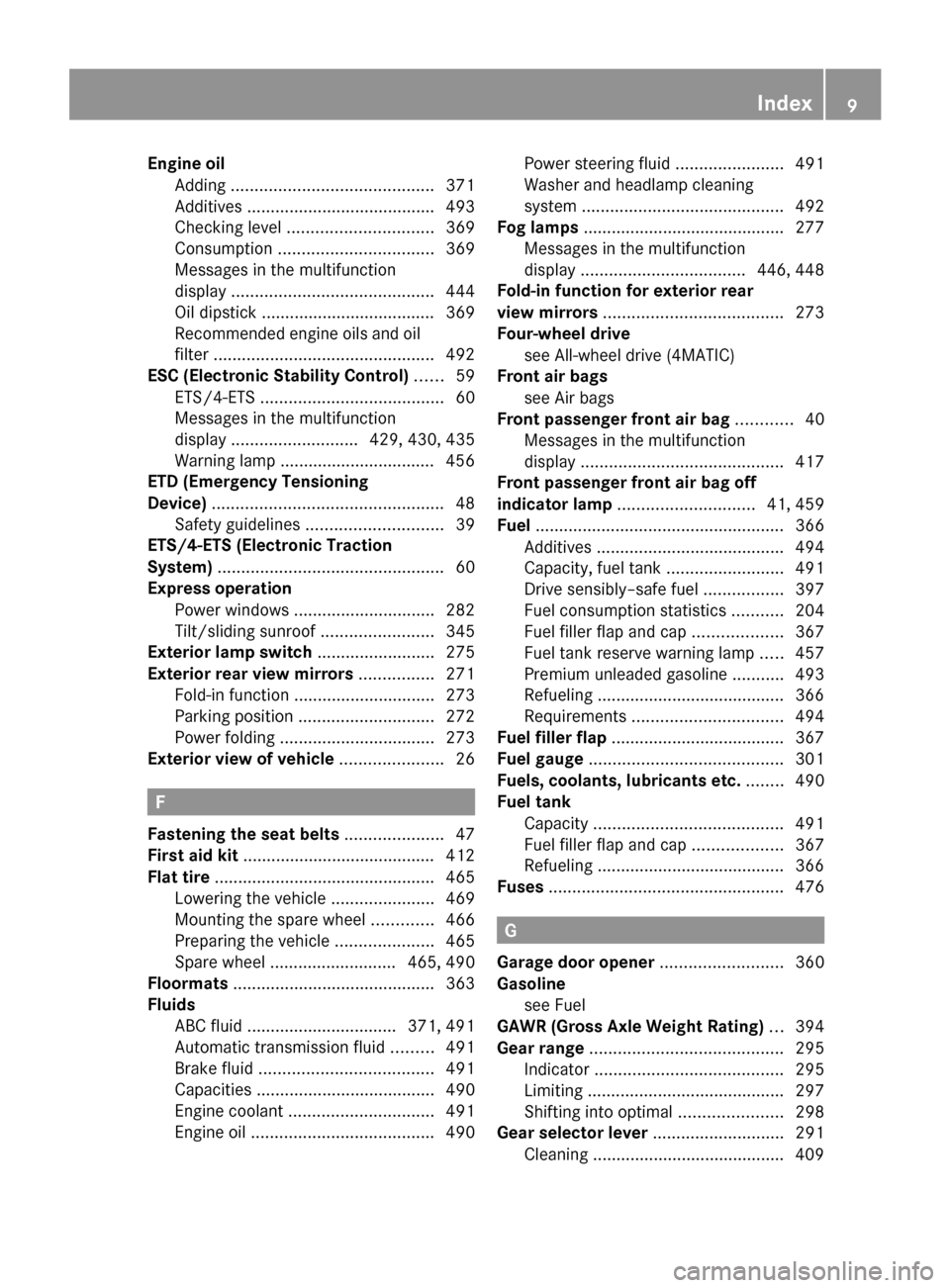
Engine oil
Adding ........................................... 371
Additives ........................................ 493
Checking level ............................... 369
Consumption ................................. 369
Messages in the multifunction
display ........................................... 444
Oil dipstick .....................................
369
Recommended engine oils and oil
filter ............................................... 492
ESC (Electronic Stability Control) ......59
ETS/4-ETS ....................................... 60
Messages in the multifunction
display ........................... 429, 430, 435
Warning lamp ................................. 456
ETD (Emergency Tensioning
Device) ................................................. 48
Safety guidelines ............................. 39
ETS/4-ETS (Electronic Traction
System) ................................................ 60
Express operation Power windows .............................. 282
Tilt/sliding sunroof ........................345
Exterior lamp switch ......................... 275
Exterior rear view mirrors ................271
Fold-in function .............................. 273
Parking position ............................. 272
Power folding ................................. 273
Exterior view of vehicle ......................26 F
Fastening the seat belts .....................47
First aid kit .........................................
412
Flat tire
............................................... 465
Lowering the vehicle ......................469
Mounting the spare wheel ............. 466
Preparing the vehicle .....................465
Spare wheel ........................... 465, 490
Floormats ........................................... 363
Fluids
ABC fluid ................................ 371, 491
Automatic transmission fluid ......... 491
Brake fluid ..................................... 491
Capacities ...................................... 490
Engine coolant ............................... 491
Engine oil ....................................... 490Power steering fluid .......................
491
Washer and headlamp cleaning
system ........................................... 492
Fog lamps ........................................... 277
Messages in the multifunction
display
................................... 446, 448
Fold-in function for exterior rear
view mirrors ...................................... 273
Four-wheel drive see All-wheel drive (4MATIC)
Front air bags
see Air bags
Front passenger front air bag ............ 40
Messages in the multifunction
display ........................................... 417
Front passenger front air bag off
indicator lamp ............................. 41, 459
Fuel ..................................................... 366
Additives ........................................ 494
Capacity, fuel tank ......................... 491
Drive sensibly–safe fuel .................397
Fuel consumption statistics ...........204
Fuel filler flap and cap ................... 367
Fuel tank reserve warning lamp .....457
Premium unleaded gasoline ...........493
Refueling ........................................ 366
Requirements ................................ 494
Fuel filler flap ..................................... 367
Fuel gauge ......................................... 301
Fuels, coolants, lubricants etc. ........490
Fuel tank Capacity ........................................ 491
Fuel filler flap and cap ................... 367
Refueling ........................................ 366
Fuses .................................................. 476 G
Garage door opener .......................... 360
Gasoline see Fuel
GAWR (Gross Axle Weight Rating) ...394
Gear range ......................................... 295
Indicator ........................................ 295
Limiting .......................................... 297
Shifting into optimal ......................298
Gear selector lever ............................291
Cleaning ......................................... 409 Index
9 216_AKB; 3; 90, en-US
d2ureepe,
Version: 2.11.8.1 2009-05-15T11:47:50+02:00 - Seite 9
Page 206 of 500
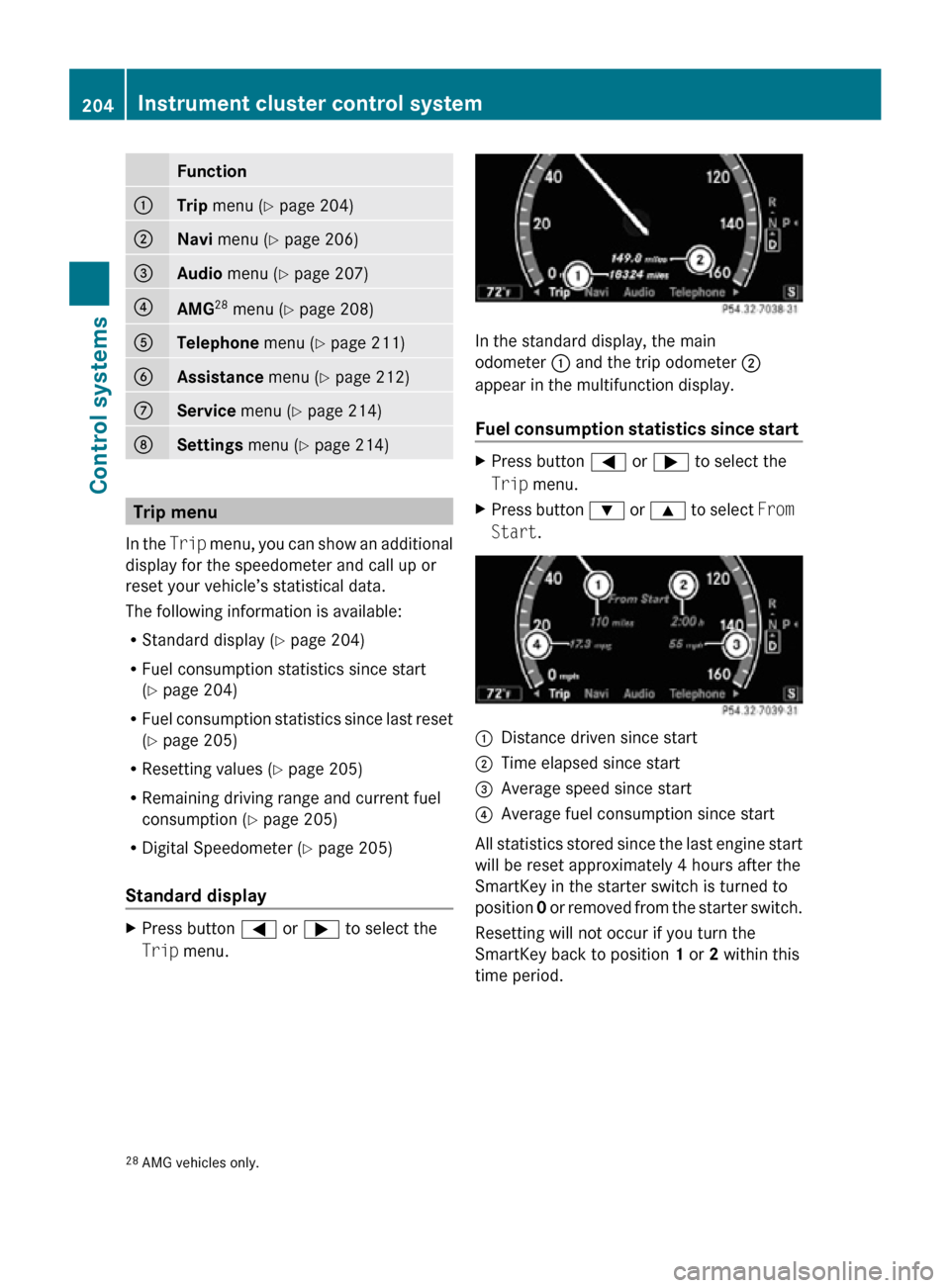
Function
:
Trip
menu (Y page 204) ;
Navi menu (Y page 206)
=
Audio
menu (Y page 207) ?
AMG
28
menu (Y page 208) A
Telephone
menu (Y page 211) B
Assistance
menu (Y page 212) C
Service
menu (Y page 214) D
Settings menu (Y page 214)
Trip menu
In the Trip menu, you can show an additional
display for the speedometer and call up or
reset your vehicle’s statistical data.
The following information is available:
R Standard display ( Y page 204)
R Fuel consumption statistics since start
(Y page 204)
R Fuel consumption statistics since last reset
(Y page 205)
R Resetting values ( Y page 205)
R Remaining driving range and current fuel
consumption (Y page 205)
R Digital Speedometer ( Y page 205)
Standard display X
Press button = or ; to select the
Trip menu. In the standard display, the main
odometer : and the trip odometer ;
appear in the multifunction display.
Fuel consumption statistics since start
X
Press button = or ; to select the
Trip menu.
X Press button : or 9 to select From
Start. :
Distance driven since start
; Time elapsed since start
= Average speed since start
? Average fuel consumption since start
All statistics stored since the last engine start
will be reset approximately 4 hours after the
SmartKey in the starter switch is turned to
position 0 or removed from the starter switch.
Resetting will not occur if you turn the
SmartKey back to position 1 or 2 within this
time period.
28 AMG vehicles only. 204
Instrument cluster control systemControl systems
216_AKB; 3; 90, en-US
d2ureepe,
Version: 2.11.8.1 2009-05-15T11:47:50+02:00 - Seite 204
Page 207 of 500
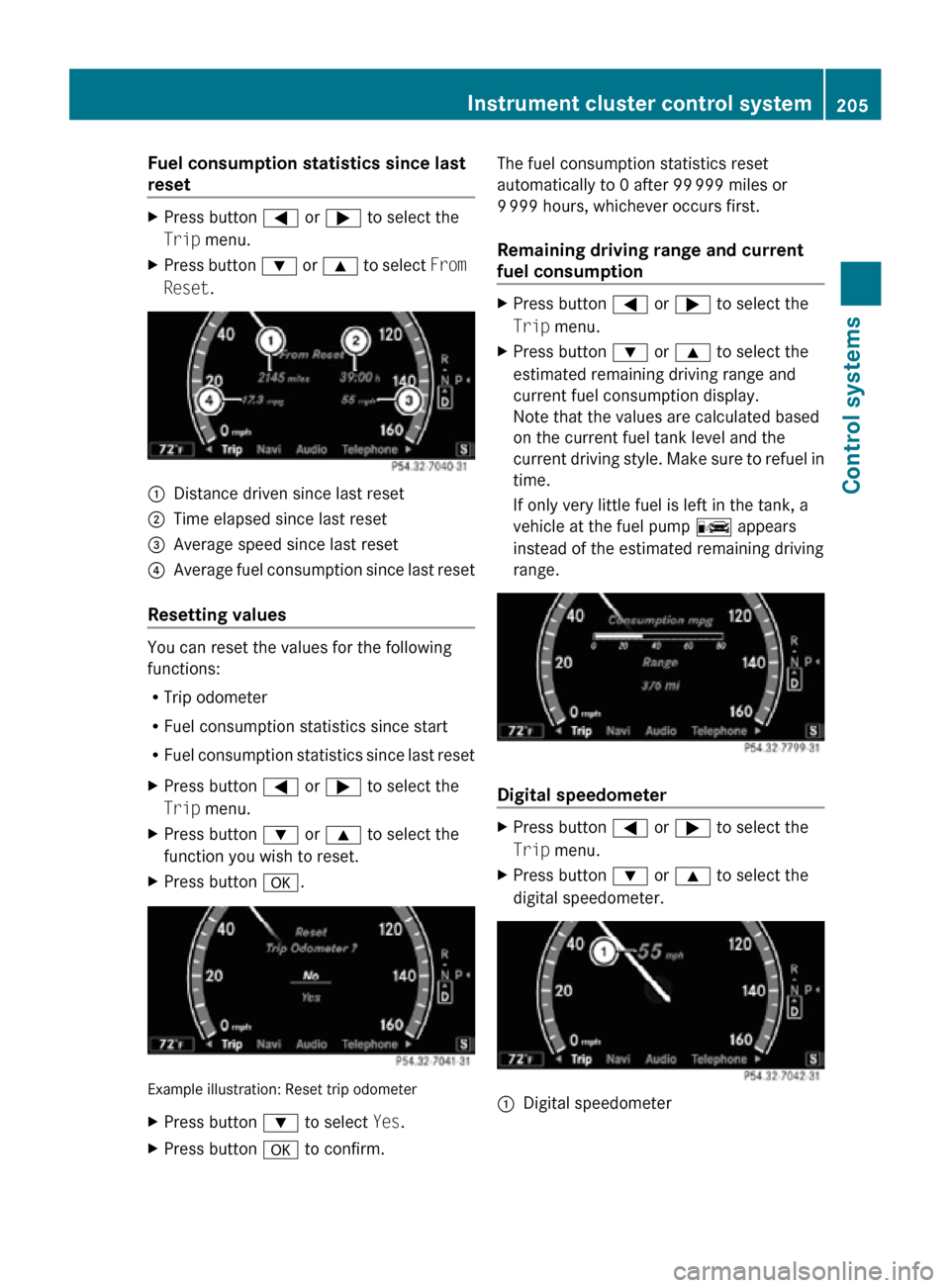
Fuel consumption statistics since last
reset
X
Press button = or ; to select the
Trip menu.
X Press button : or 9 to select From
Reset. :
Distance driven since last reset
; Time elapsed since last reset
= Average speed since last reset
? Average fuel consumption since last reset
Resetting values You can reset the values for the following
functions:
R
Trip odometer
R Fuel consumption statistics since start
R Fuel consumption statistics since last reset
X Press button = or ; to select the
Trip menu.
X Press button : or 9 to select the
function you wish to reset.
X Press button a. Example illustration: Reset trip odometer
X
Press button : to select Yes.
X Press button a to confirm. The fuel consumption statistics reset
automatically to 0 after 99
999 miles or
9 999 hours, whichever occurs first.
Remaining driving range and current
fuel consumption X
Press button = or ; to select the
Trip menu.
X Press button : or 9 to select the
estimated remaining driving range and
current fuel consumption display.
Note that the values are calculated based
on the current fuel tank level and the
current driving style. Make sure to refuel in
time.
If only very little fuel is left in the tank, a
vehicle at the fuel pump C appears
instead of the estimated remaining driving
range. Digital speedometer
X
Press button = or ; to select the
Trip menu.
X Press button : or 9 to select the
digital speedometer. :
Digital speedometer Instrument cluster control system
205Control systems
216_AKB; 3; 90, en-US
d2ureepe, Version: 2.11.8.1 2009-05-15T11:47:50+02:00 - Seite 205 Z
Page 320 of 500
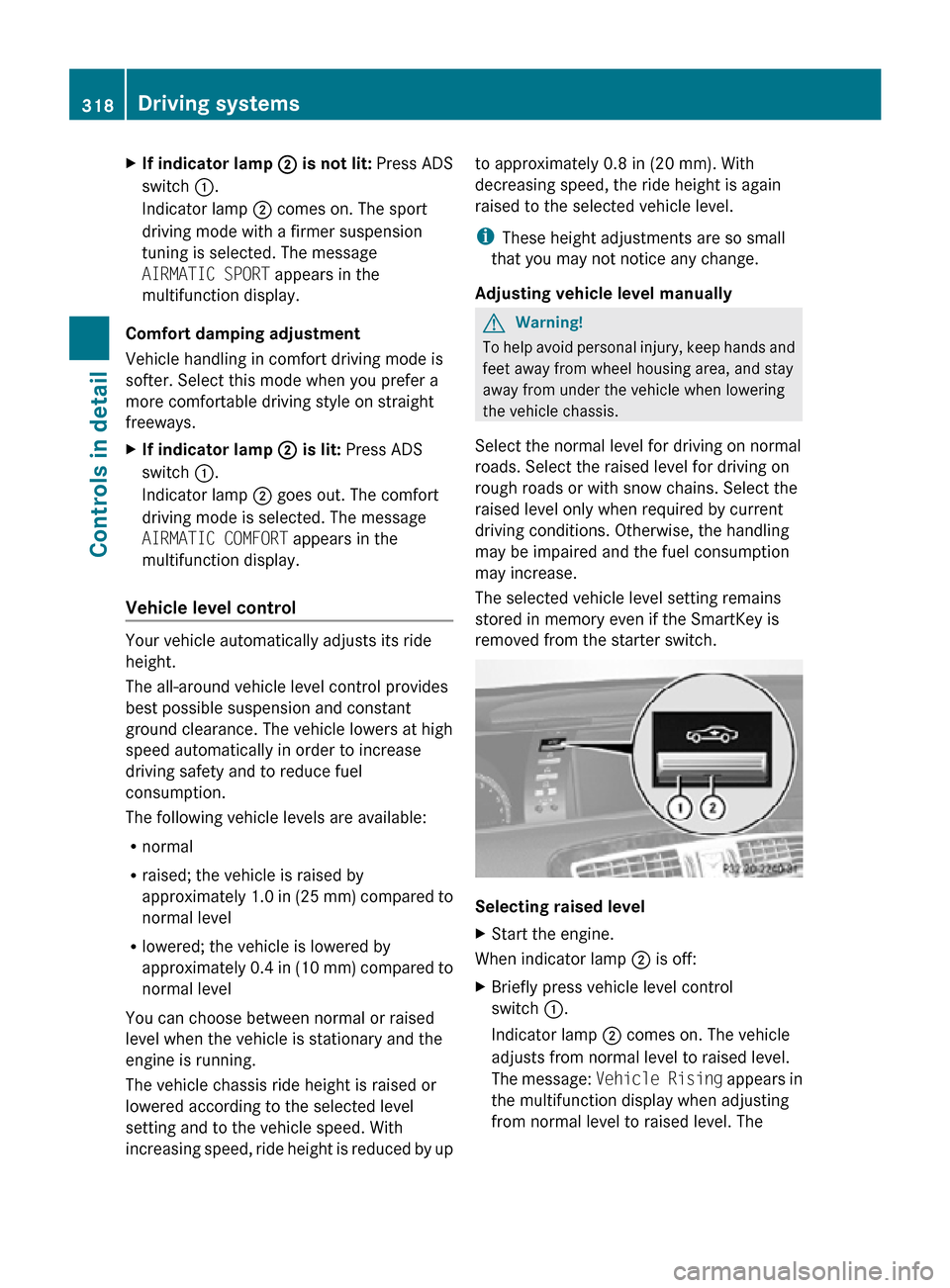
X
If indicator lamp ; is not lit: Press ADS
switch :.
Indicator lamp ; comes on. The sport
driving mode with a firmer suspension
tuning is selected. The message
AIRMATIC SPORT appears in the
multifunction display.
Comfort damping adjustment
Vehicle handling in comfort driving mode is
softer. Select this mode when you prefer a
more comfortable driving style on straight
freeways.
X If indicator lamp ; is lit: Press ADS
switch :.
Indicator lamp ; goes out. The comfort
driving mode is selected. The message
AIRMATIC COMFORT appears in the
multifunction display.
Vehicle level control Your vehicle automatically adjusts its ride
height.
The all-around vehicle level control provides
best possible suspension and constant
ground clearance. The vehicle lowers at high
speed automatically in order to increase
driving safety and to reduce fuel
consumption.
The following vehicle levels are available:
R
normal
R raised; the vehicle is raised by
approximately 1.0 in (25 mm) compared to
normal level
R lowered; the vehicle is lowered by
approximately 0.4 in (10 mm) compared to
normal level
You can choose between normal or raised
level when the vehicle is stationary and the
engine is running.
The vehicle chassis ride height is raised or
lowered according to the selected level
setting and to the vehicle speed. With
increasing speed, ride height is reduced by up to approximately 0.8 in (20 mm). With
decreasing speed, the ride height is again
raised to the selected vehicle level.
i
These height adjustments are so small
that you may not notice any change.
Adjusting vehicle level manually G
Warning!
To help avoid personal injury, keep hands and
feet away from wheel housing area, and stay
away from under the vehicle when lowering
the vehicle chassis.
Select the normal level for driving on normal
roads. Select the raised level for driving on
rough roads or with snow chains. Select the
raised level only when required by current
driving conditions. Otherwise, the handling
may be impaired and the fuel consumption
may increase.
The selected vehicle level setting remains
stored in memory even if the SmartKey is
removed from the starter switch. Selecting raised level
X
Start the engine.
When indicator lamp ; is off:
X Briefly press vehicle level control
switch :.
Indicator lamp ; comes on. The vehicle
adjusts from normal level to raised level.
The message: Vehicle Rising appears in
the multifunction display when adjusting
from normal level to raised level. The 318
Driving systemsControls in detail
216_AKB; 3; 90, en-US
d2ureepe,
Version: 2.11.8.1 2009-05-15T11:47:50+02:00 - Seite 318
Page 321 of 500
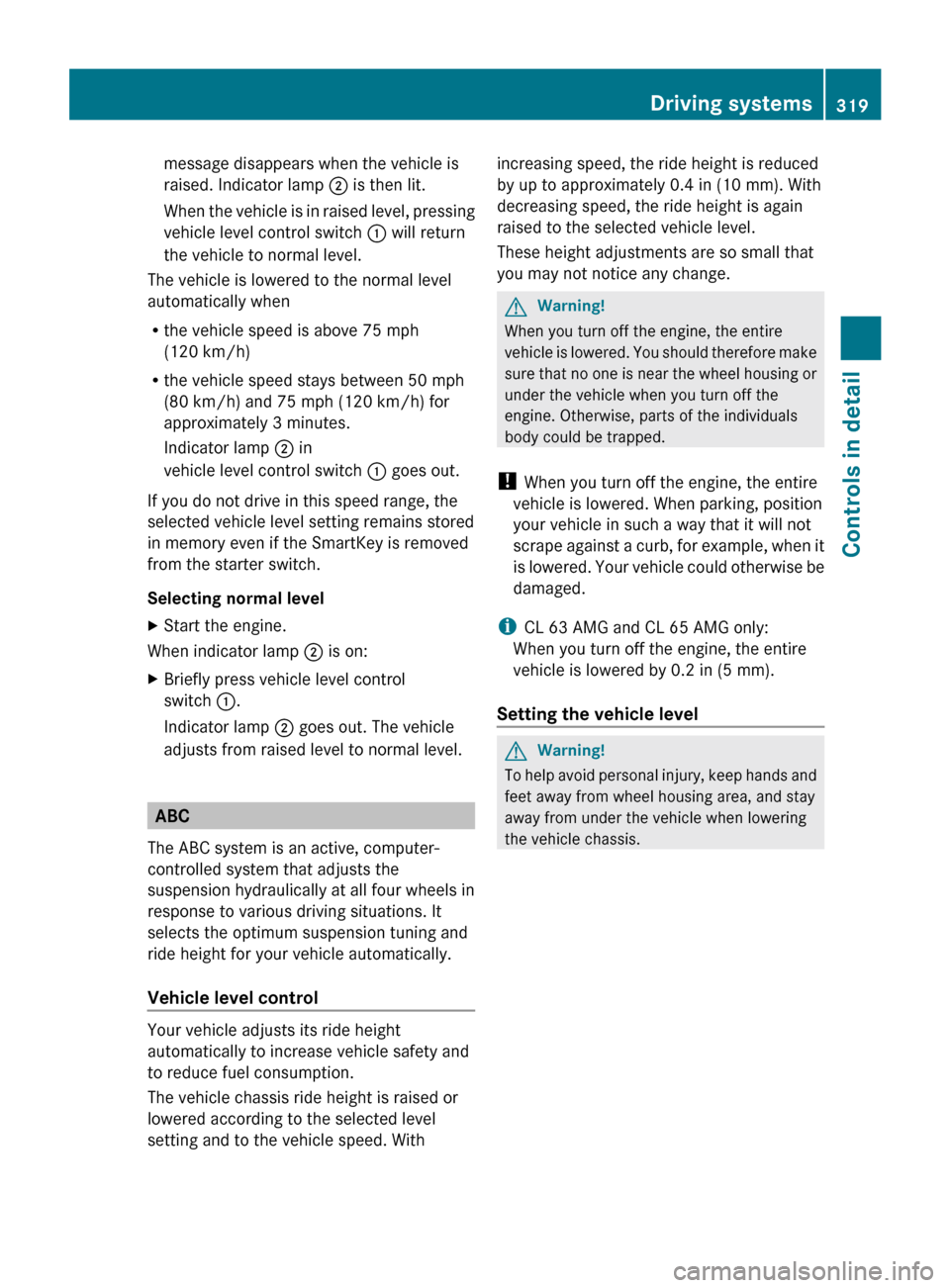
message disappears when the vehicle is
raised. Indicator lamp
; is then lit.
When the
vehicle is in raised level, pressing
vehicle level control switch : will return
the vehicle to normal level.
The vehicle is lowered to the normal level
automatically when
R the vehicle speed is above 75 mph
(120 km/h)
R the vehicle speed stays between 50 mph
(80 km/h) and 75 mph (120 km/h) for
approximately 3 minutes.
Indicator lamp
; in
vehicle level control switch : goes out.
If you do not drive in this speed range, the
selected vehicle level setting remains stored
in memory even if the SmartKey is removed
from the starter switch.
Selecting normal level
X Start the engine.
When indicator lamp ; is on:
X Briefly press vehicle level control
switch :.
Indicator lamp ; goes out. The vehicle
adjusts from raised level to normal level. ABC
The ABC system is an active, computer-
controlled system that adjusts the
suspension hydraulically at all four wheels in
response to various driving situations. It
selects the optimum suspension tuning and
ride height for your vehicle automatically.
Vehicle level control Your vehicle adjusts its ride height
automatically to increase vehicle safety and
to reduce fuel consumption.
The vehicle chassis ride height is raised or
lowered according to the selected level
setting and to the vehicle speed. With increasing speed, the ride height is reduced
by up to approximately 0.4 in
(10 mm). With
decreasing speed, the ride height is again
raised to the selected vehicle level.
These height adjustments are so small that
you may not notice any change. G
Warning!
When you turn off the engine, the entire
vehicle is
lowered. You should therefore make
sure that no one is near the wheel housing or
under the vehicle when you turn off the
engine. Otherwise, parts of the individuals
body could be trapped.
! When you turn off the engine, the entire
vehicle is lowered. When parking, position
your vehicle in such a way that it will not
scrape against a curb, for example, when it
is lowered. Your vehicle could otherwise be
damaged.
i CL 63 AMG and CL 65 AMG only:
When you turn off the engine, the entire
vehicle is lowered by 0.2 in (5 mm).
Setting the vehicle level G
Warning!
To help avoid personal injury, keep hands and
feet away from wheel housing area, and stay
away from under the vehicle when lowering
the vehicle chassis. Driving systems
319
Controls in detail
216_AKB; 3; 90, en-US
d2ureepe, Version: 2.11.8.1 2009-05-15T11:47:50+02:00 - Seite 319 Z
Page 322 of 500
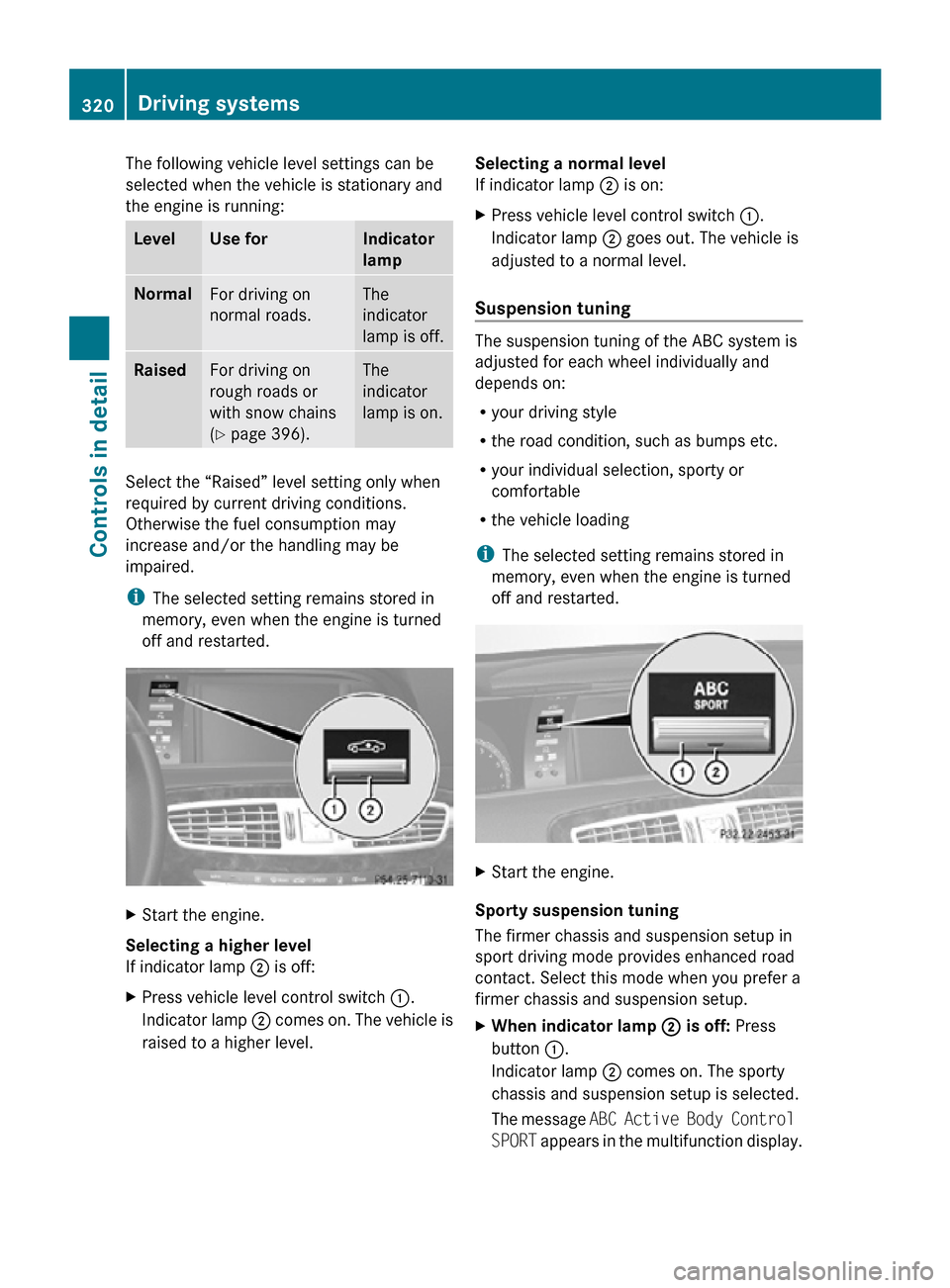
The following vehicle level settings can be
selected when the vehicle is stationary and
the engine is running:
Level Use for Indicator
lamp
Normal
For driving on
normal roads. The
indicator
lamp is off.
Raised
For driving on
rough roads or
with snow chains
(Y page 396). The
indicator
lamp is on.
Select the “Raised” level setting only when
required by current driving conditions.
Otherwise the fuel consumption may
increase and/or the handling may be
impaired.
i
The selected setting remains stored in
memory, even when the engine is turned
off and restarted. X
Start the engine.
Selecting a higher level
If indicator lamp ; is off:
X Press vehicle level control switch :.
Indicator lamp ; comes on. The vehicle is
raised to a higher level. Selecting a normal level
If indicator lamp ; is on:
X
Press vehicle level control switch :.
Indicator lamp ; goes out. The vehicle is
adjusted to a normal level.
Suspension tuning The suspension tuning of the ABC system is
adjusted for each wheel individually and
depends on:
R
your driving style
R the road condition, such as bumps etc.
R your individual selection, sporty or
comfortable
R the vehicle loading
i The selected setting remains stored in
memory, even when the engine is turned
off and restarted. X
Start the engine.
Sporty suspension tuning
The firmer chassis and suspension setup in
sport driving mode provides enhanced road
contact. Select this mode when you prefer a
firmer chassis and suspension setup.
X When indicator lamp ; is off: Press
button :.
Indicator lamp ; comes on. The sporty
chassis and suspension setup is selected.
The message ABC Active Body Control
SPORT appears in the multifunction display. 320
Driving systemsControls in detail
216_AKB; 3; 90, en-US
d2ureepe,
Version: 2.11.8.1 2009-05-15T11:47:50+02:00 - Seite 320
Page 399 of 500
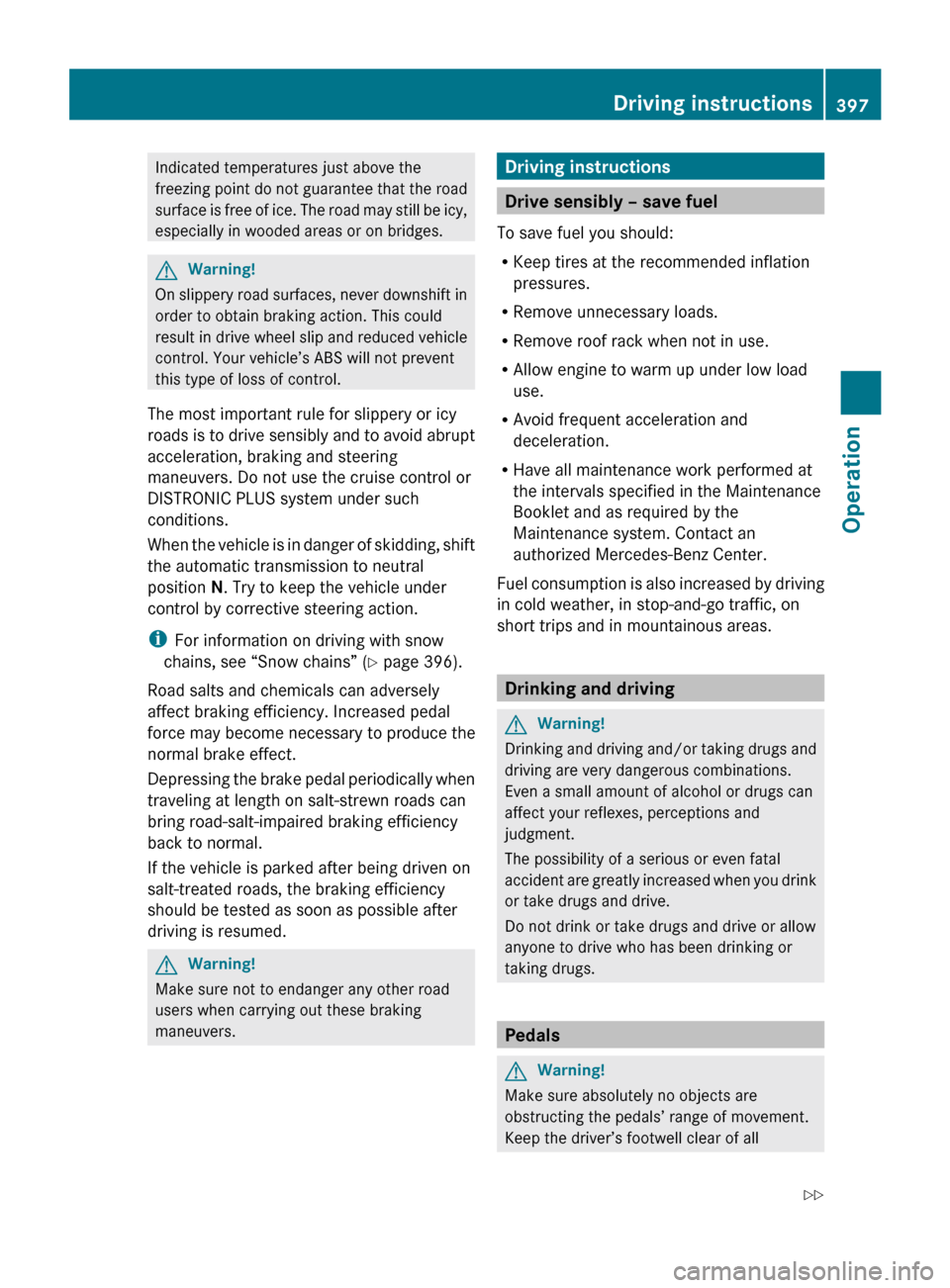
Indicated temperatures just above the
freezing
point
do not guarantee that the road
surface is free of ice. The road may still be icy,
especially in wooded areas or on bridges. G
Warning!
On slippery road surfaces, never downshift in
order to obtain braking action. This could
result in
drive wheel slip and reduced vehicle
control. Your vehicle’s ABS will not prevent
this type of loss of control.
The most important rule for slippery or icy
roads is to drive sensibly and to avoid abrupt
acceleration, braking and steering
maneuvers. Do not use the cruise control or
DISTRONIC PLUS system under such
conditions.
When the vehicle is in danger of skidding, shift
the automatic transmission to neutral
position N. Try to keep the vehicle under
control by corrective steering action.
i For information on driving with snow
chains, see “Snow chains” ( Y page 396).
Road salts and chemicals can adversely
affect braking efficiency. Increased pedal
force may become necessary to produce the
normal brake effect.
Depressing the brake pedal periodically when
traveling at length on salt-strewn roads can
bring road-salt-impaired braking efficiency
back to normal.
If the vehicle is parked after being driven on
salt-treated roads, the braking efficiency
should be tested as soon as possible after
driving is resumed. G
Warning!
Make sure not to endanger any other road
users when carrying out these braking
maneuvers. Driving instructions
Drive sensibly – save fuel
To save fuel you should:
R Keep tires at the recommended inflation
pressures.
R Remove unnecessary loads.
R Remove roof rack when not in use.
R Allow engine to warm up under low load
use.
R Avoid frequent acceleration and
deceleration.
R Have all maintenance work performed at
the intervals specified in the Maintenance
Booklet and as required by the
Maintenance system. Contact an
authorized Mercedes-Benz Center.
Fuel consumption
is also increased by driving
in cold weather, in stop-and-go traffic, on
short trips and in mountainous areas. Drinking and driving
G
Warning!
Drinking and driving and/or taking drugs and
driving are very dangerous combinations.
Even a small amount of alcohol or drugs can
affect your reflexes, perceptions and
judgment.
The possibility of a serious or even fatal
accident are
greatly increased when you drink
or take drugs and drive.
Do not drink or take drugs and drive or allow
anyone to drive who has been drinking or
taking drugs. Pedals
G
Warning!
Make sure absolutely no objects are
obstructing the pedals’ range of movement.
Keep the driver’s footwell clear of all Driving instructions
397
Operation
216_AKB; 3; 90, en-US
d2ureepe, Version: 2.11.8.1 2009-05-15T11:47:50+02:00 - Seite 397 Z
Page 488 of 500
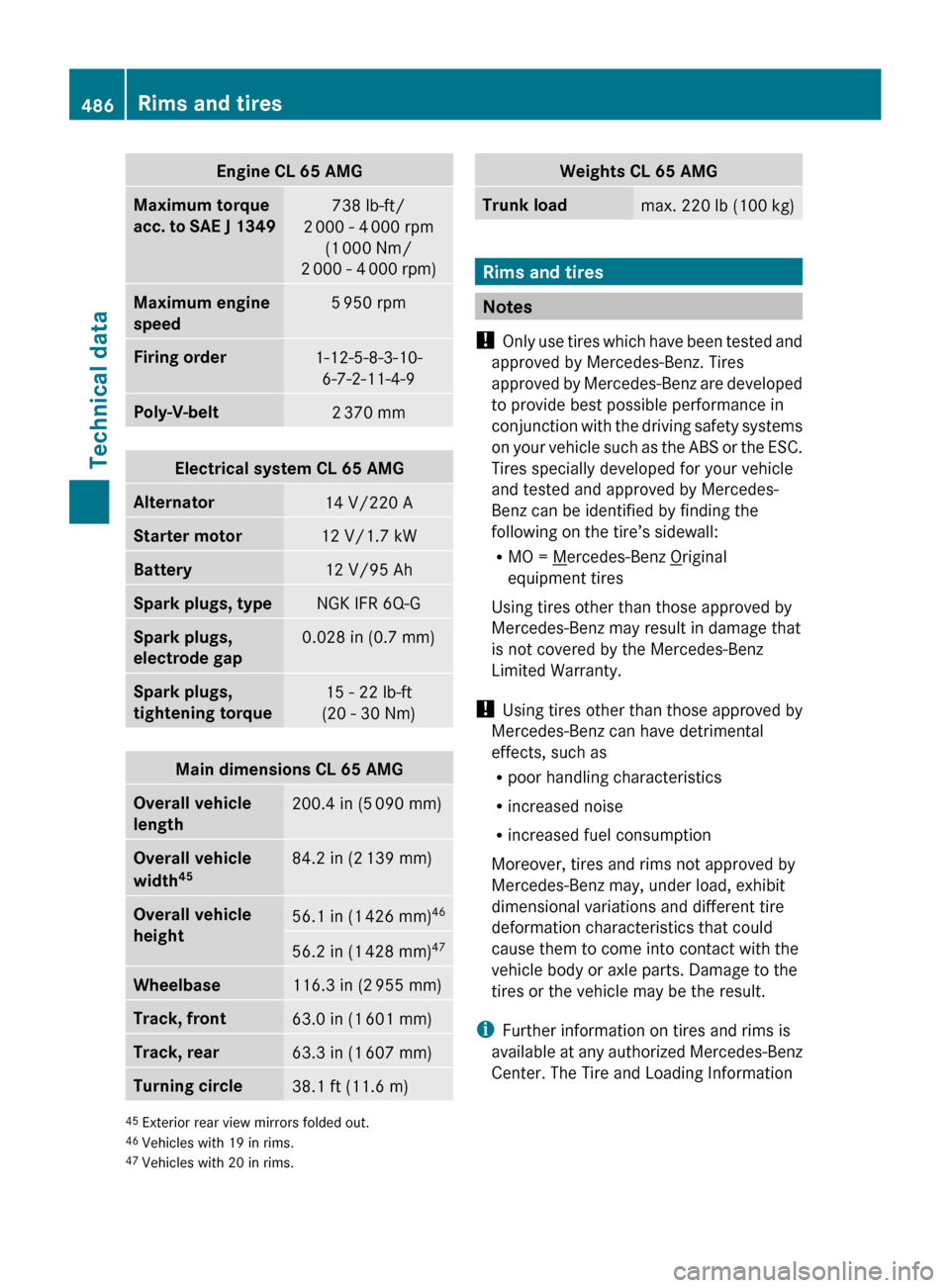
Engine CL 65 AMG
Maximum torque
acc.
to
SAE J 1349 738 lb-ft/
2 000 - 4 000 rpm
(1 000 Nm/
2 000 - 4 000 rpm) Maximum engine
speed
5 950 rpm
Firing order
1-12-5-8-3-10-
6-7-2-11-4-9 Poly-V-belt
2 370 mm
Electrical system CL 65 AMG
Alternator
14 V/220 A
Starter motor
12 V/1.7 kW
Battery
12 V/95 Ah
Spark plugs, type
NGK IFR 6Q-G
Spark plugs,
electrode gap
0.028 in (0.7 mm)
Spark plugs,
tightening torque
15 - 22 lb-ft
(20 - 30 Nm) Main dimensions CL 65 AMG
Overall vehicle
length
200.4 in (5
090 mm) Overall vehicle
width
45 84.2 in (2
139 mm) Overall vehicle
height
56.1 in (1
426 mm) 46 56.2 in (1
428 mm) 47 Wheelbase
116.3 in (2
955 mm) Track, front
63.0 in (1
601 mm) Track, rear
63.3 in (1
607 mm) Turning circle
38.1 ft (11.6 m) Weights CL 65 AMG
Trunk load
max. 220 lb (100 kg)
Rims and tires
Notes
! Only use
tires which have been tested and
approved by Mercedes-Benz. Tires
approved by Mercedes-Benz are developed
to provide best possible performance in
conjunction with the driving safety systems
on your vehicle such as the ABS or the ESC.
Tires specially developed for your vehicle
and tested and approved by Mercedes-
Benz can be identified by finding the
following on the tire’s sidewall:
R MO = Mercedes-Benz Original
equipment tires
Using tires other than those approved by
Mercedes-Benz may result in damage that
is not covered by the Mercedes-Benz
Limited Warranty.
! Using tires other than those approved by
Mercedes-Benz can have detrimental
effects, such as
R poor handling characteristics
R increased noise
R increased fuel consumption
Moreover, tires and rims not approved by
Mercedes-Benz may, under load, exhibit
dimensional variations and different tire
deformation characteristics that could
cause them to come into contact with the
vehicle body or axle parts. Damage to the
tires or the vehicle may be the result.
i Further information on tires and rims is
available at
any authorized Mercedes-Benz
Center. The Tire and Loading Information
45 Exterior rear view mirrors folded out.
46 Vehicles with 19 in rims.
47 Vehicles with 20 in rims. 486
Rims and tires
Technical data
216_AKB; 3; 90, en-US
d2ureepe,
Version: 2.11.8.1 2009-05-15T11:47:50+02:00 - Seite 486